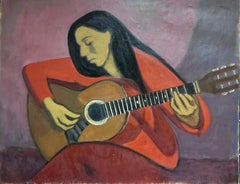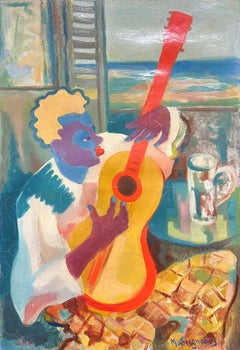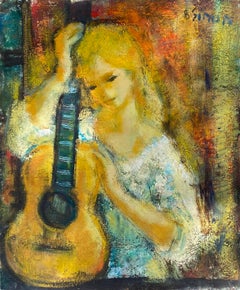Items Similar to Woman and guitar oil on board painting fauvism
Video Loading
Want more images or videos?
Request additional images or videos from the seller
1 of 13
Jordi CurosWoman and guitar oil on board painting fauvism1980
1980
$790.77
£588.57
€660
CA$1,083.16
A$1,204.71
CHF 629.06
MX$14,660.09
NOK 8,034.11
SEK 7,534.58
DKK 5,024.35
Shipping
Retrieving quote...The 1stDibs Promise:
Authenticity Guarantee,
Money-Back Guarantee,
24-Hour Cancellation
About the Item
Jordi Curós Ventura (1930-2007) - Woman - Oil on board.
Work measurements 46x38 cm.
Frame size 64x56 cm.
Jordi Curós Ventura (Olot, Girona, March 4, 1930) is a Spanish painter.
He trained at the Olot School of Arts and Crafts, a center of great artistic tradition. His first individual exhibition was held in the Garden of Barcelona galleries in 1950. In 1951, he began his participation in the October Salons of Barcelona. Among the Catalan artists that emerged from this important demonstration, Curós stood out, from the beginning, for his pictorial faculties and personality. Between 1958 and 1963 his painting goes through a stage of abstract tendency, with colorful arabesques and paintings with enamel qualities. Later, he will assume a figurative style characterized by the importance of light and the interest in instant capture. He belonged to the Parés room group, where he exhibited successive times between 1965 and 1989.
His work is perfectly recognized, from the first stage, figurative, contemporary to the aforementioned Halls, of masses of colors clearly delimited by a marked drawing, until the current form, back to the representation, of more nuanced color, going through its stage informalist, in that his basal paintings, forming a kind of ovals, were recognized by their personal concept. In his informal era, he is attracted, by the material possibilities, by performing large-scale works, also the use of bright enamels that "turn his painting into a continuous exaltation of the textural-chromatic factor", according to Lourdes Cirlot. Carlos Areán, affirms that his painting "has evolved from a traditional figurativism of wide planes, marked volumes and solid structure, towards a technically studied use of the most varied new materials, with the consequent suppression of any objective pretext ".
The influence of Informalism gives way to images taken of the natural in marine environments and markets full of flowers and fruits. The colors are piled in successive layers that overlap even on plaster to give the canvas textures of a great boldness. Figures and colors almost Fauve coexist in it with abstract pieces that allow to enjoy a different and absolutely personal vision of life.
He personally exhibited in Barcelona: Sala Caralt (1952/53); Galleries Layetanas (1953); Syra Galleries (1954-55); Vayreda Hall (1956-59). In Madrid, his presentation took effect in 1953, in Biosca Galleries. He also did it individually at the Mendoza Galleries in Caracas.
In 1952 he was selected by Eugenio d'Ors to appear in the X Hall of the Eleven and in 1953 he participated in the II Hispano-American Biennial of Havana, appearing in large groups such as the III Spanish-American Biennial, Space and Color in the Spanish Painting today (Rio de Janeiro, 1959 and Montevideo, 1960). Current Catalan painting (Lisbon and Porto, 1960) or Figure, informal tribute to Diego Velázquez (1960); Contrasts in the current Spanish painting (Brussels, 1961); 3rd Granollers Prize for Painting, High-tapestry Tapestries, Contemporary Artists Tapestries (Biosca Galleries, 1961), May Room, Independence Hall.
Gaudí of two scholarships, awarded in 1954, the first by the French Institute of Barcelona, to move to Paris, and the second in 1958, with the same objective, is endowed by the Barcelona City Council. In 1953 the Museum of Modern Art of Barcelona acquired a work of his. First Exhibition of Merit Artists of the Royal Artistic Circle of Barcelona - Sitges2011. Jordi Curós is one of the Merit Artists of the Royal Artistic Circle of Barcelona who participates in the First collective exhibition of the mentioned Merit Partners.
Great painter, inspired by the Costa Brava, whose splendor is reflected in all his work. He has exhibited in the best rooms and art galleries in his country. His work is also exhibited in various museums throughout Spain.
"The color, which has always been very present in the work of Curós, now expresses the joy of the moment in which he lives, once assumed by the intelligence of the disturbing complexity of the passions." Josep María Cadena.
Jordi Curós' work has deserved numerous international awards and galleries as legendary as El Cisne de Madrid have had him on his list of artists. Also the Museum of Contemporary Art of Barcelona and the Royal Artistic Circle of the Catalan capital, where the price of his paintings grows steadily as the years go by.
Jordi Curos
Jordi Curós Ventura (Olot, Girona, March 4, 1930) is a Spanish painter. He trained at the Olot School of Arts and Crafts, a center of great artistic tradition. His first individual exhibition was held in the Garden of Barcelona galleries in 1950. In 1951, he began his participation in the October Salons of Barcelona. Among the Catalan artists that emerged from this important demonstration, Curós stood out, from the beginning, for his pictorial faculties and personality. Between 1958 and 1963 his painting goes through a stage of abstract tendency, with colorful arabesques and paintings with enamel qualities. Later, he will assume a figurative style characterized by the importance of light and the interest in instant capture. He belonged to the Parés room group, where he exhibited successive times between 1965 and 1989. His work is perfectly recognized, from the first stage, figurative, contemporary to the aforementioned Halls, of masses of colors clearly delimited by a marked drawing, until the current form, back to the representation, of more nuanced color, going through its stage informalist, in that his basal paintings, forming a kind of ovals, were recognized by their personal concept. In his informal era, he is attracted, by the material possibilities, by performing large-scale works, also the use of bright enamels that "turn his painting into a continuous exaltation of the textural-chromatic factor", according to Lourdes Cirlot. Carlos Areán, affirms that his painting "has evolved from a traditional figurativism of wide planes, marked volumes and solid structure, towards a technically studied use of the most varied new materials, with the consequent suppression of any objective pretext ". The influence of Informalism gives way to images taken of the natural in marine environments and markets full of flowers and fruits. The colors are piled in successive layers that overlap even on plaster to give the canvas textures of a great boldness. Figures and colors almost Fauve coexist in it with abstract pieces that allow to enjoy a different and absolutely personal vision of life. He personally exhibited in Barcelona: Sala Caralt (1952/53); Galleries Layetanas (1953); Syra Galleries (1954-55); Vayreda Hall (1956-59). In Madrid, his presentation took effect in 1953, in Biosca Galleries. He also did it individually at the Mendoza Galleries in Caracas. In 1952 he was selected by Eugenio d'Ors to appear in the X Hall of the Eleven and in 1953 he participated in the II Hispano-American Biennial of Havana, appearing in large groups such as the III Spanish-American Biennial, Space and Color in the Spanish Painting today (Rio de Janeiro, 1959 and Montevideo, 1960). Current Catalan painting (Lisbon and Porto, 1960) or Figure, informal tribute to Diego Velázquez (1960); Contrasts in the current Spanish painting (Brussels, 1961); 3rd Granollers Prize for Painting, High-tapestry Tapestries, Contemporary Artists Tapestries (Biosca Galleries, 1961), May Room, Independence Hall. Gaudí of two scholarships, awarded in 1954, the first by the French Institute of Barcelona, to move to Paris.
About the Seller
5.0
Platinum Seller
Premium sellers with a 4.7+ rating and 24-hour response times
Established in 2007
1stDibs seller since 2019
440 sales on 1stDibs
Typical response time: 1 hour
- ShippingRetrieving quote...Shipping from: sitges, Spain
- Return Policy
Authenticity Guarantee
In the unlikely event there’s an issue with an item’s authenticity, contact us within 1 year for a full refund. DetailsMoney-Back Guarantee
If your item is not as described, is damaged in transit, or does not arrive, contact us within 7 days for a full refund. Details24-Hour Cancellation
You have a 24-hour grace period in which to reconsider your purchase, with no questions asked.Vetted Professional Sellers
Our world-class sellers must adhere to strict standards for service and quality, maintaining the integrity of our listings.Price-Match Guarantee
If you find that a seller listed the same item for a lower price elsewhere, we’ll match it.Trusted Global Delivery
Our best-in-class carrier network provides specialized shipping options worldwide, including custom delivery.More From This Seller
View AllWoman posing with guitar acrylic painting
By Jordi Curos
Located in Barcelona, Barcelona
Jordi Curós Ventura (1930-2007) - Woman
Acrylic on canvas on cardboard.
Work measurements 55x46 cm.
Frameless.
Jordi Curós Ventura (Olot, Girona, March 4, 1930) is a Spanish painter...
Category
1970s Fauvist Portrait Paintings
Materials
Acrylic
woman with guitar mixed media painting
By Jordi Curos
Located in Barcelona, Barcelona
Jordi Curós Ventura (1930-2007) - Woman
Mixed technique on canvas cardboard.
Work measurements 46x38 cm.
Frameless.
Jordi Curós Ventura (Olot, Girona, March 4, 1930) is a Spanish pa...
Category
1980s Fauvist Portrait Paintings
Materials
Mixed Media
Woman with Guitar mixed media painting
Located in Barcelona, Barcelona
Title: Woman with Guitar
Artist: Jordi Curós Ventura (1930–2017)
Technique: Mixed media on canvas board
Dimensions: 46 x 55 cm
Framed: No
Period: Second half of the 20th century
Sign...
Category
1970s Fauvist Mixed Media
Materials
Mixed Media
$575 Sale Price
20% Off
woman with guitar mixed media painting
By Jordi Curos
Located in Barcelona, Barcelona
Jordi Curós Ventura (1930-2007) - Woman smoking
Mixed technique on canvas board.
Work measurements 55x46 cm.
Frameless.
Jordi Curós Ventura (Olot, Girona, March 4, 1930) is a Spanis...
Category
1980s Fauvist Portrait Paintings
Materials
Mixed Media
$479 Sale Price
33% Off
Woman posing with guitar mixed media painting
By Jordi Curos
Located in Barcelona, Barcelona
Jordi Curós Ventura (1930-2007) - Woman
Mixed technique on canvas cardboard.
Work measurements 46x38 cm.
Frameless.
Jordi Curós Ventura (Olot, Girona, March 4, 1930) is a Spanish pa...
Category
1970s Fauvist Portrait Paintings
Materials
Mixed Media
$364 Sale Price
24% Off
Woman posing with guitar mixed media painting
By Jordi Curos
Located in Barcelona, Barcelona
Jordi Curós Ventura (1930-2007) - Woman
Mixed technique on canvas cardboard.
Work measurements 46x38 cm.
Frameless.
Jordi Curós Ventura (Olot, Girona, March 4, 1930) is a Spanish pa...
Category
1970s Fauvist Portrait Paintings
Materials
Mixed Media
$325 Sale Price
22% Off
You May Also Like
Woman with a Guitar, Painting, Oil on Canvas
By Tanya Grabkova
Located in Yardley, PA
This original oil and acrylic painting ΓÇ£Woman with a GuitarΓÇ¥ is painted by inspired Picasso. :: Painting :: Modern :: This piece comes with an official certificate of authentici...
Category
2010s Modern Paintings
Materials
Oil
Huge 1960's French Modernist Oil Painting Lady Seated Playing Guitar
Located in Cirencester, Gloucestershire
The Guitar Player
French Modernist artist, circa 1960's period
oil on canvas, unframed
canvas : 32 x 39.5 inches
provenance: private collection, France
condition: very good and sound...
Category
Mid-20th Century Modern Figurative Paintings
Materials
Oil
Vibrant Cubist Portrait of a Musician with Guitar Mid 20th Century Painting
Located in Cirencester, Gloucestershire
Cubist Portrait of a Musician
Marcel Seignobos (1892-1972)
signed oil on canvas, unframed
Canvas : 22 x 15 inches
Provenance: private collection, Cote d'Azur, France
Condition: very...
Category
Mid-20th Century Impressionist Figurative Paintings
Materials
Oil
“Girl with Guitar”
Located in Southampton, NY
Original oil on canvas painting of a young girl with guitar by the Russian/French artist, Boris Simon. Signed top right. Circa 1955. Condition is excellent...
Category
1950s Post-Modern Figurative Paintings
Materials
Canvas, Oil
$1,250 Sale Price
32% Off
'Woman Playing Guitar', California Post Impressionist oil, Santa Cruz, San Jose
By Jonathan Taylor
Located in Santa Cruz, CA
Painted circa 2000 by Jonathan Taylor (American, born 1968) and accompanied by a Certificate of Authenticity.
This listed California artist first studied art at the College of the Atlantic in Bal Harbor...
Category
1990s Modern Figurative Paintings
Materials
Oil, Board
Woman with Guitar and Pianist
Located in San Francisco, CA
This Artwork "Woman with Guitar and Pianist" c.1990 is a color serigraph, with extensive acrylic paint on canvas. It is signed at the lower right cor...
Category
Late 20th Century Fauvist Mixed Media
Materials
Mixed Media
More Ways To Browse
Catalan Paintings
Painting With Oval Frame
Fauvist Style Paintings
Oval Oil Painting
Guitar Oil Painting
Arabesque Paintings
Oval Flower Painting
Fauvist Flowers
French Flower Market Oil
Independence Hall
Spanish Guitar
Lisbon Oil Painting
Woman With Guitar
Royal Paris Tapestry
Carlos Salas
Jordi Curos
Village Girls
Andrea Signed Paintings



